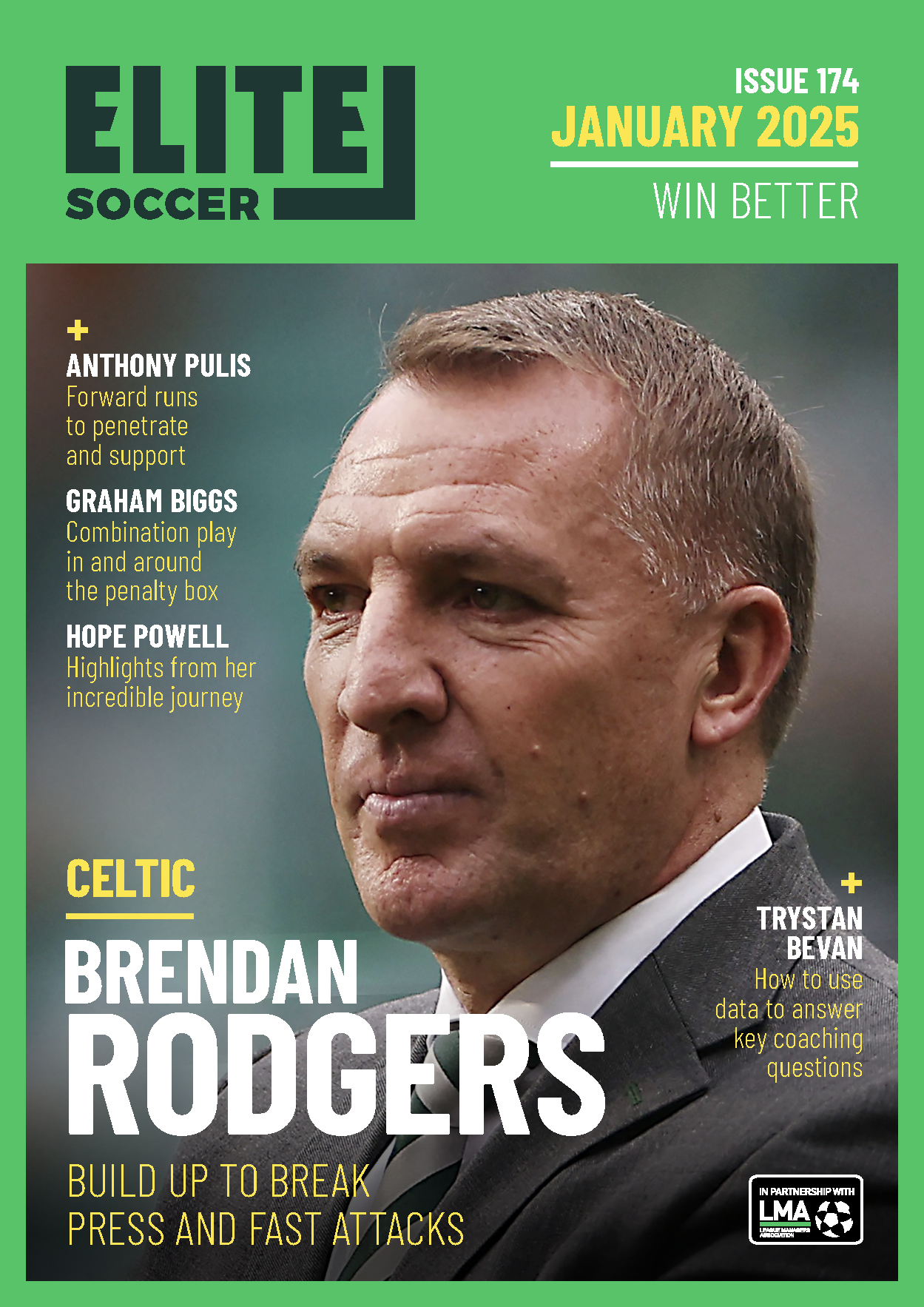You are viewing 1 of your 1 free articles
Attacking against a 1-5-3-2 formation
The main aim of this session is to prepare a team playing in a 1-4-4-3 system with a possession style, to beat an opponent playing in a 1-5-3-2 defensive system through a specific building-up game plan. There are some important key points needed to attack teams with this formation when they are in a low defensive block with a lot of players behind the ball.
| Area | Half pitch |
| Equipment | Balls, bibs, cones, 2 full size goals |
| No. of Players | Up to 20 players + 2 goalkeepers |
| Session Time | Player video presentation: 15mins Warm-up: 15mins Training the strategies: 15mins Attack v defence: 20mins |
The main aim of this session is to prepare a team playing in a 1-4-4-3 system with a possession style, to beat an opponent playing in a 1-5-3-2 defensive system through a specific building-up game plan.
There are some important key points needed to attack teams with this formation when they are in a low defensive block with a lot of players behind the ball. To highlight these we find it necessary to do a deep analysis of a previous game to develop a suitable training plan, as this will prepare our players to beat a team playing in this formation.
The 1-5-3-2 system has been used throughout football history, and there are some teams that can be considered as references to be analysed so our players can gain more knowledge about how the defensive phase works. Due to a number of successful teams that have used this system in recent years, there have also been a greater number of coaches using the formation as their main set-up system.
Additionally, when the game is analysed, it is common to observe that when teams playing with four in the defensive line are without ball, they are dominated by the opposition and, defending in a low block, the defensive midfielder is embedded between the centre backs, also creating a fixed defensive line of five players.
Possession-based teams who try to dominate the opposition through long attacking phases, need to have strategies to overcome this low defensive block and as coaches we need to lead the process to achieve this.
Usually we would run this as one of the main training sessions in the middle of the week leading up to a game in which preparation to face a specific opponent is needed. The activities have high tactical, technical and physical demands, so this session can be used to achieve a general development of the player. Also, during the pre-season it is possible to run this type of session to create a higher number of tactical solutions for team preparation.
GAME ANALYSIS TO FIND ATTACKING SOLUTIONS
We start by using video analysis to examine the problems of playing against a team set up in a
1-5-3-2 formation and then we would run through the problems and the solutions on the pitch. We would set up on half a pitch with one goal and a goalkeeper. We’re using 20 outfield players. The red attacking team are setup in a 4-3-3 formation while the blue defending team are setup in a 1-5-3-2 formation, as shown [1a]. The coach would be working with the red attacking team with the aim of beating the opposition’s low defensive block by playing around, through it or over it.
After a game analysis focusing on how 1-5-3-2 teams defend in a low block, the attacking positioning of our players could be considered as a key point of the game. There would be limited space to play through the lines centrally due to the compact and narrow shape of the three blue midfield players. We identify that the attacking team should therefore switch the play from flank to flank when possible, to exploit the space on the outside of the opposition’s defensive shape and create 2v1 overload situations in wide areas, as shown [1b].
For instance, as the ball is being switched out to a winger, the striker can come across and fix the position of the nearest opposition centre back to the ball, in order to prevent the centre back from moving out wide to support the opposition full back defensively, as shown [1c]. This will leave the opposition full back in a 1v2 underload situation on the flank.
If it is not possible for the striker to get across in time, then the nearest midfield player to the ball can move forwards onto the opposition centre back to fix their position, as shown [1d].
[1a]
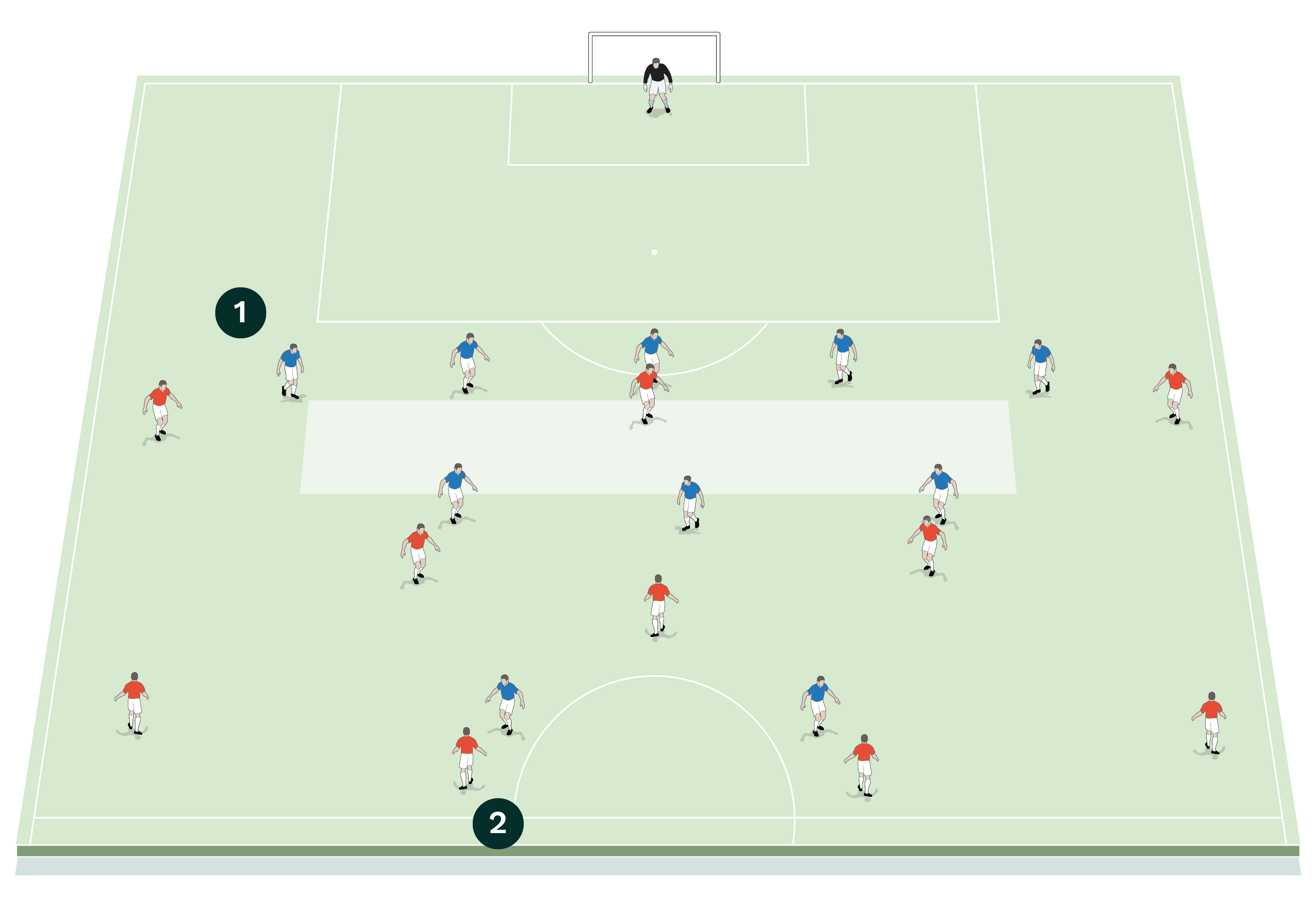
2. The red attacking team is set-up in a 4-3-3 formation. The coach works with the reds to show them how to beat the opposition’s low defensive block
[1b]
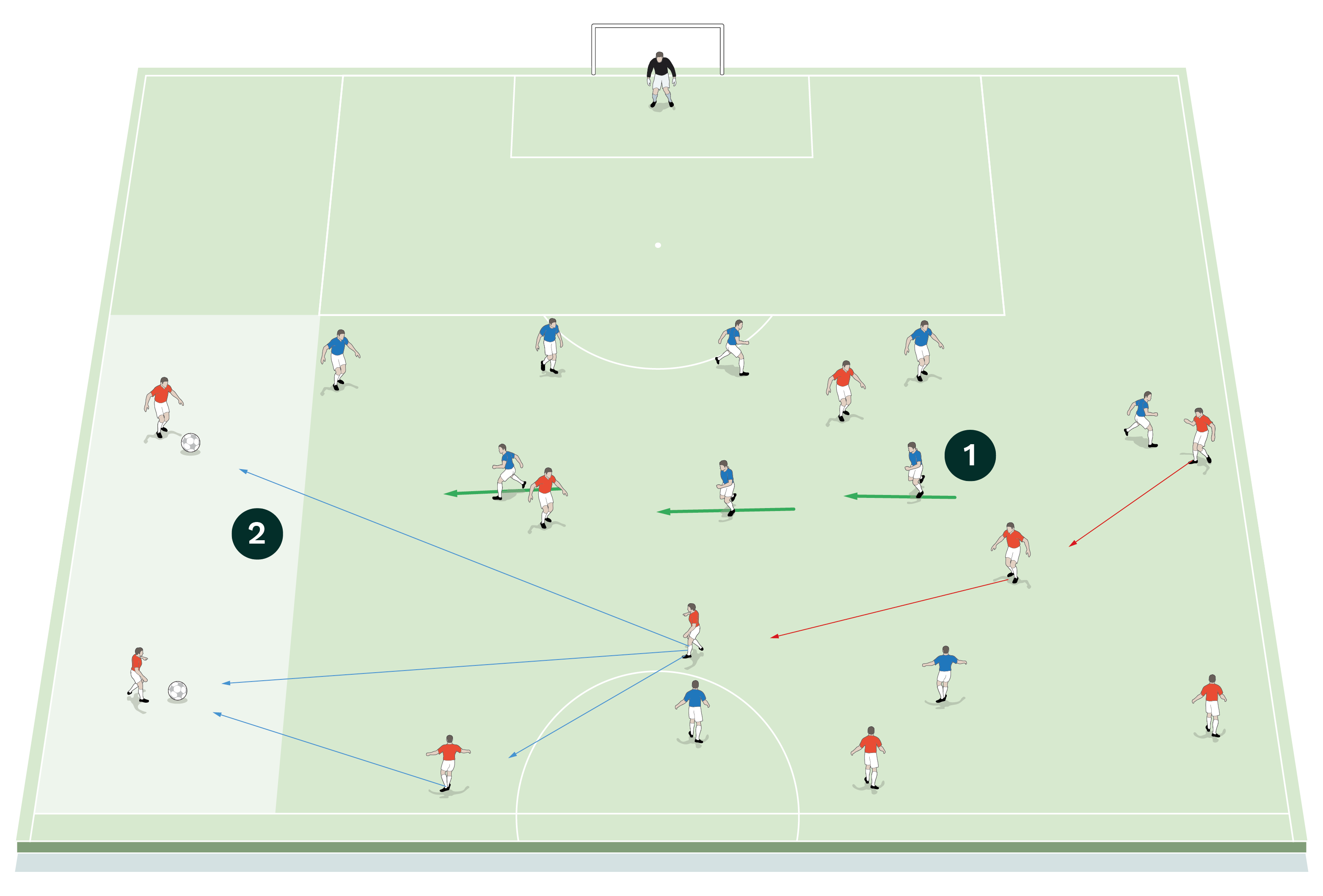
2. It is identified that the red attacking team should switch the play from flank to flank when possible, to exploit the space on the outside of the opposition’s defensive shape
[1c]
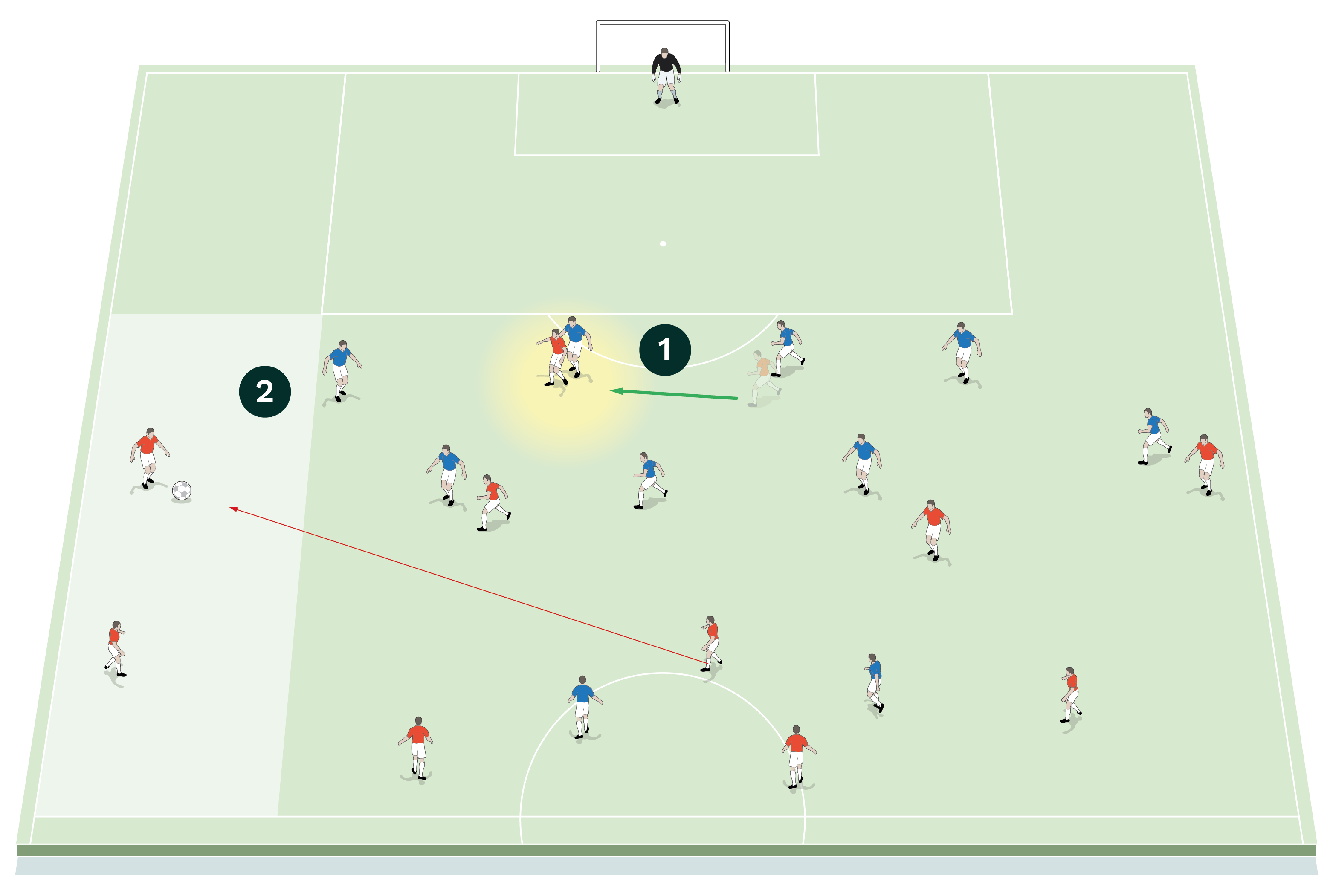
2. The blue full back will be left in a potential 1v2 underload situation on the wing, facing the red winger and a possible overlapping run by the red full back
[1d]
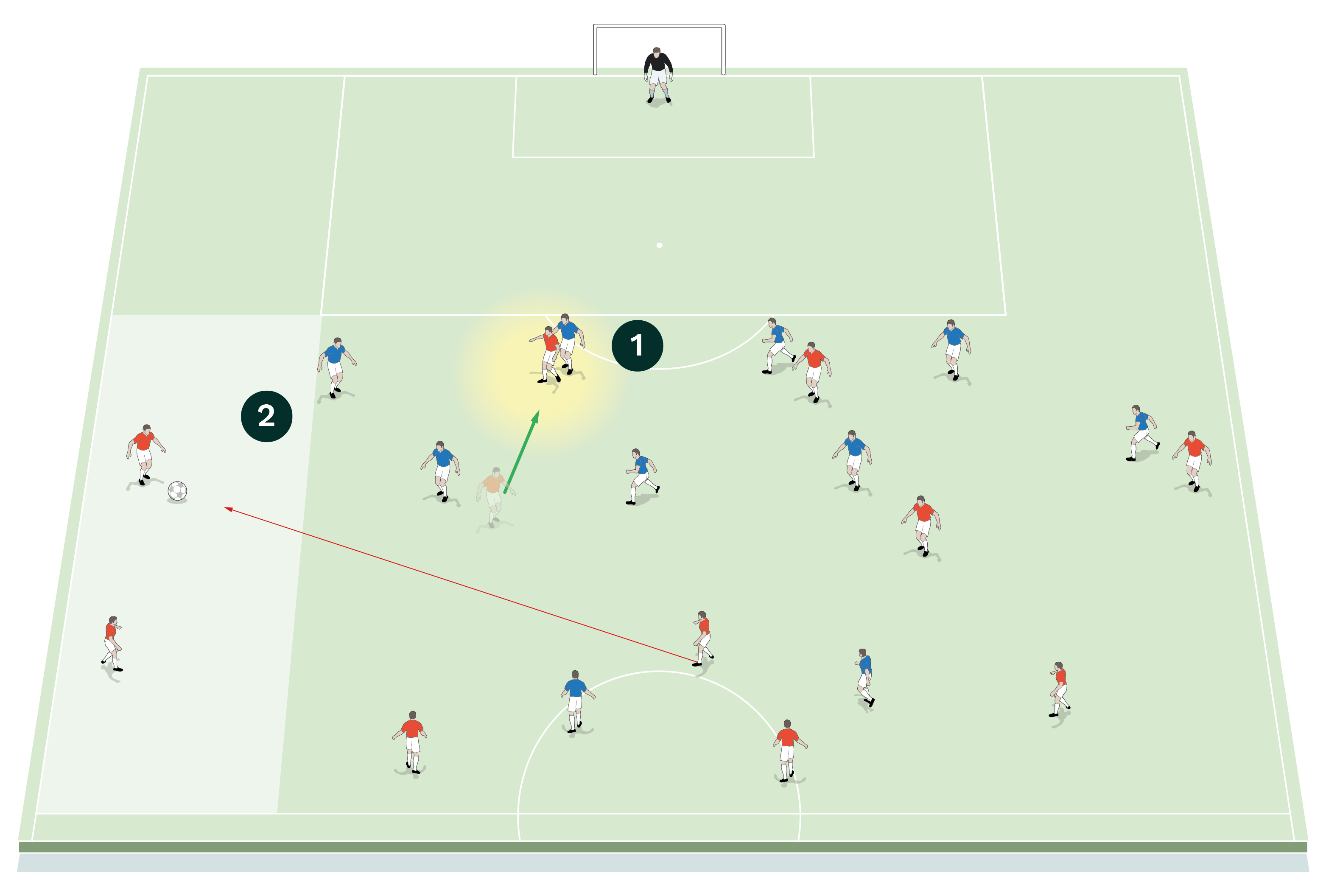
2. Again the blue full back will be left in a potential 1v2 underload situation on the wing
TRAINING THE STRATEGIES
After two or three plays from flank to flank to look at the problems, three main solutions to beat the opposition’s low defensive block can appear and we address those by incorporating these three attacking options into our training plan.
Option 1: When a central midfield player is on the ball, the winger moves infield and brings the opposition full back with them, which leaves spaces in behind for the overlapping full back to exploit by making a forward run in behind to receive a pass from the midfield player, as shown [2a].
“After two or three plays from flank to flank to look at the problems, three main solutions to beat the opposition’s low defensive block can appear”
[2a]
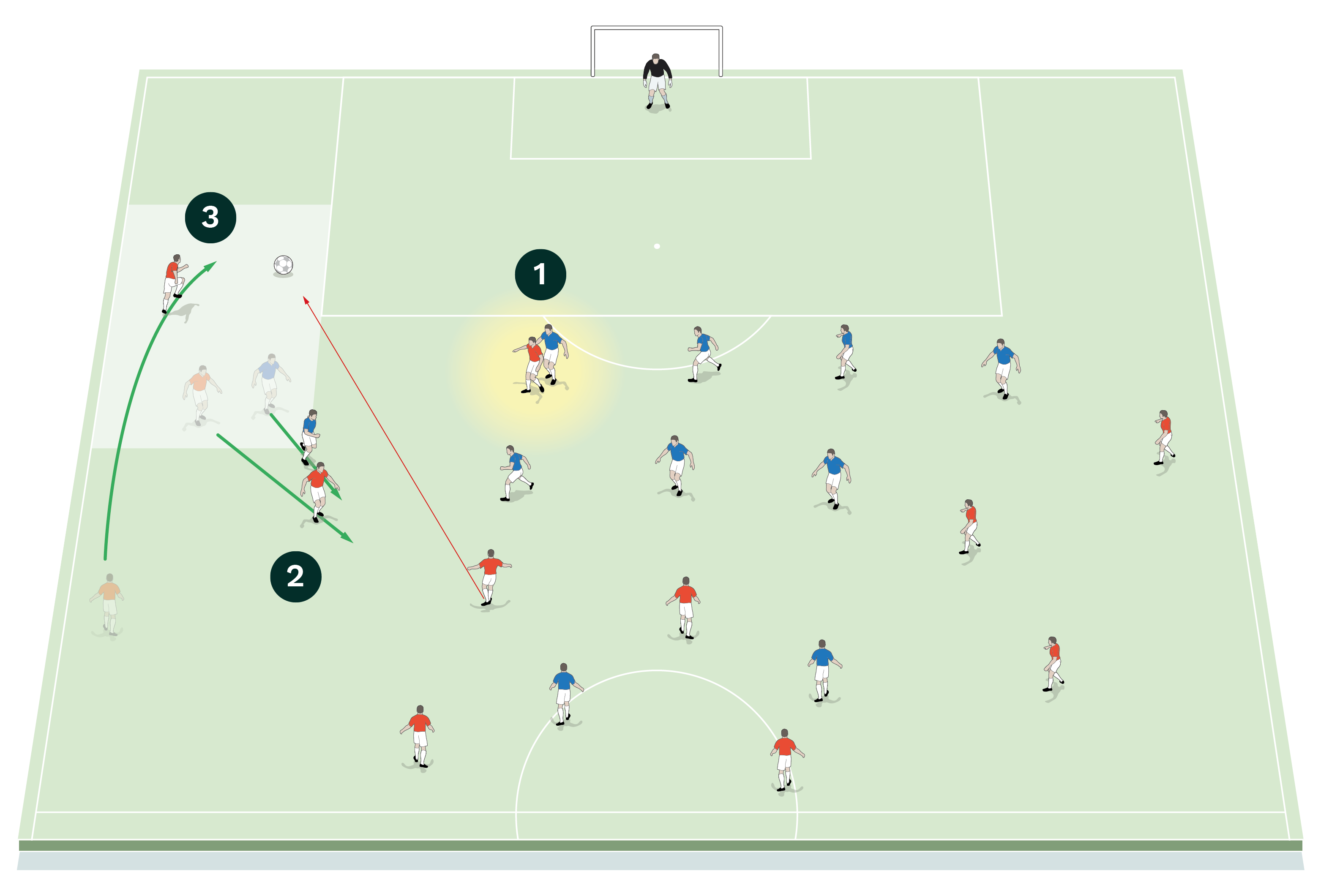
2. The red winger moves infield and drags the isolated blue full back over too
3. Space is left in behind for the overlapping full back to exploit by making a forward run to receive a pass from the midfield player
[2b]

2. The red winger has moved infield but this time the blue full back has held their position. This allows the red winger to receive and turn before looking to play a through pass for a forward run
3. The overlapping position of the attacking red full back can draw the attention of the blue full back. This can open a space to be exploited in between the blue full back and the blue centre
[2c]
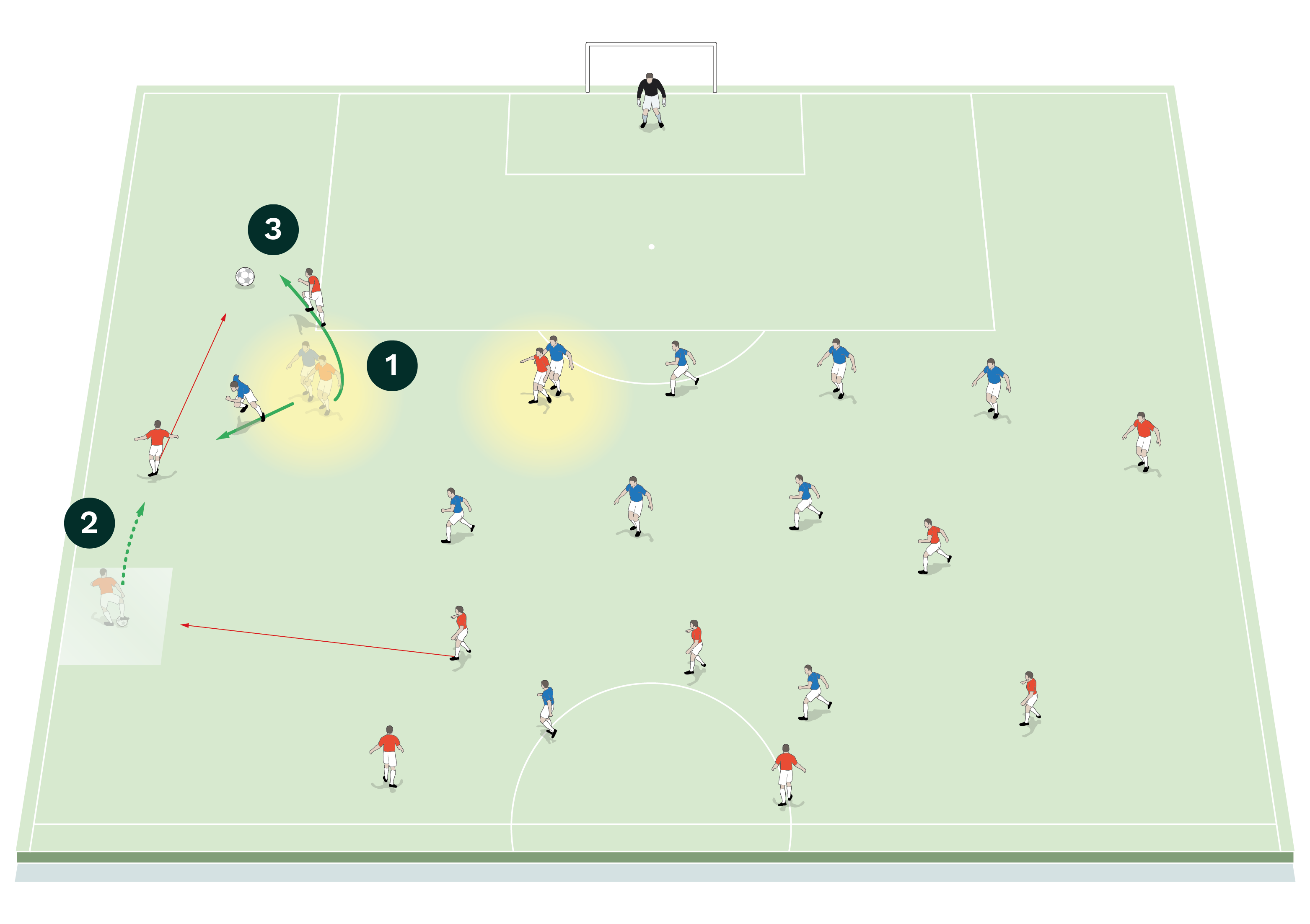
2. This time the ball is passed out wide to the red attacking full back, who advances into the space and creates a 2v1 situation down the flank
3. If the blue full back engages the red attacking full back, then a pass can be played down their outside shoulder for the red winger to run onto
Option 2: When a central midfield player is on the ball, the winger can move infield. However, on this occasion, the opposition full back holds their position rather than following. This allows the red winger to receive and turn before looking to play a through pass for a forward run, as shown [2b]. The positioning of the attacking red full back can draw the attention of the opposition full back and potentially opens a space to exploit in between the opposition full back and centre back.
Option 3: When a central midfield player is on the ball, the winger can move inside to fix the position of the opposition full back but on this occasion the ball is passed out wide to the red attacking full back, who can then advance into the space in front and create a 2v1 situation down the flank. If the blue opposition full back chooses to engage the red attacking full back, then a pass can be played down the outside shoulder of the opposition full back for the red winger who has made a forward run in behind the defence, as shown [2c].
ATTACK v DEFENCE GAME
To apply the knowledge acquired in the first exercises and analysis, we progress to an attacking training game with a full attacking team playing against eight blue defenders and a yellow forward. This is a 10v8+1 drill plus keepers and the attacking team is free to beat the block in whatever way they can.
We set up on two thirds of a pitch with a full size goal and a goalkeeper at each end. A line is marked across the pitch with cones just short of the halfway line, as shown. The red attacking team of 10 outfield players is set-up in a 1-4-3-3 formation. The blue defending team is set-up in a 1-5-3-1 formation, as shown [3a], with a yellow support player working as a forward for the blue team. The yellow becomes active when the blues win the ball and counter-attack, however the yellow cannot drop back any deeper than the coned line.
[3a]
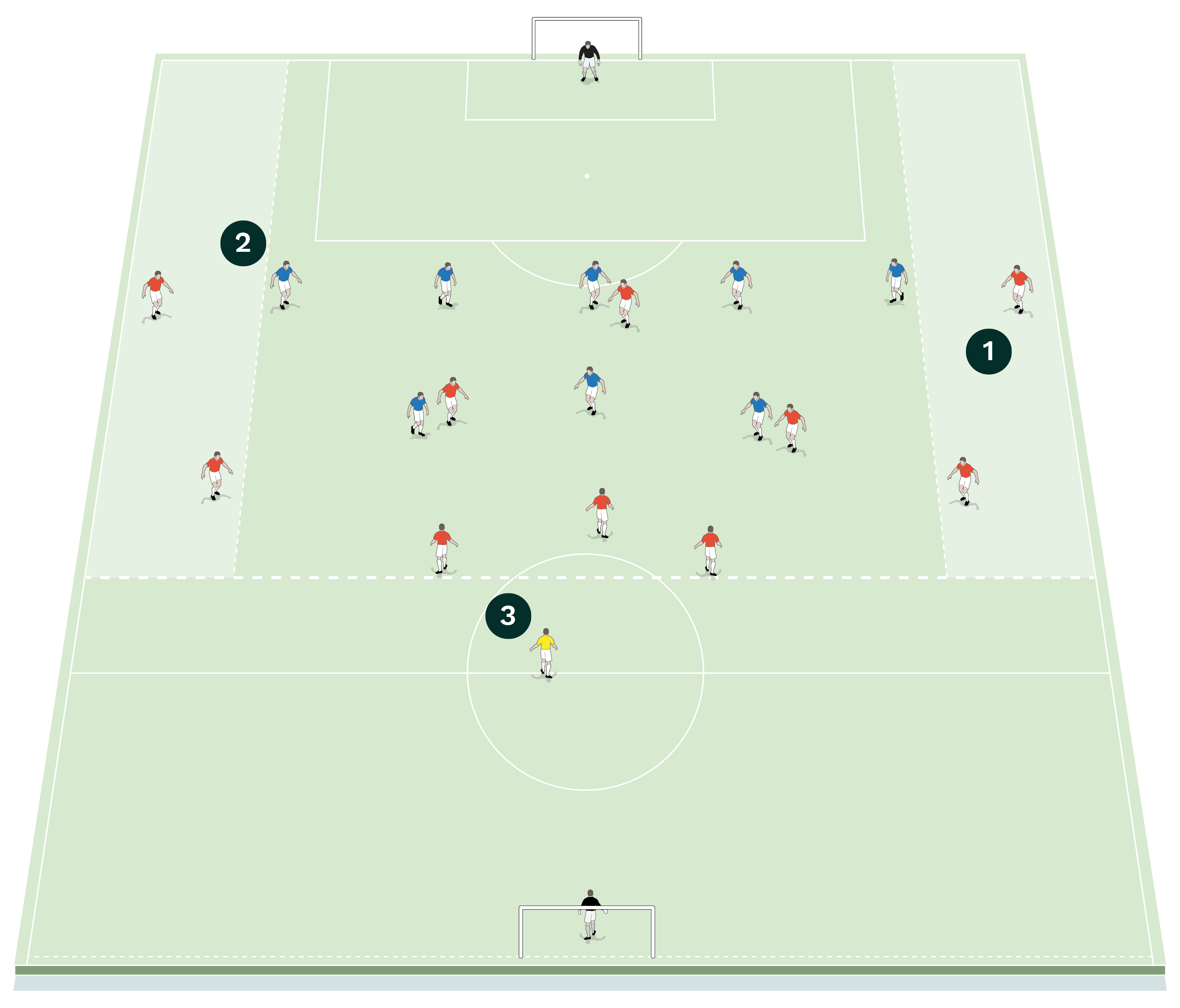
2. The blue team of 8 outfield players is set-up in a 1-5-3-1 formation and they defend the top goal. The formation includes a yellow forward up front who plays for the blues
3. The yellow forward becomes active when the blues win the ball and counter-attack, but the yellow player cannot drop back deeper than the coned line
[3b]
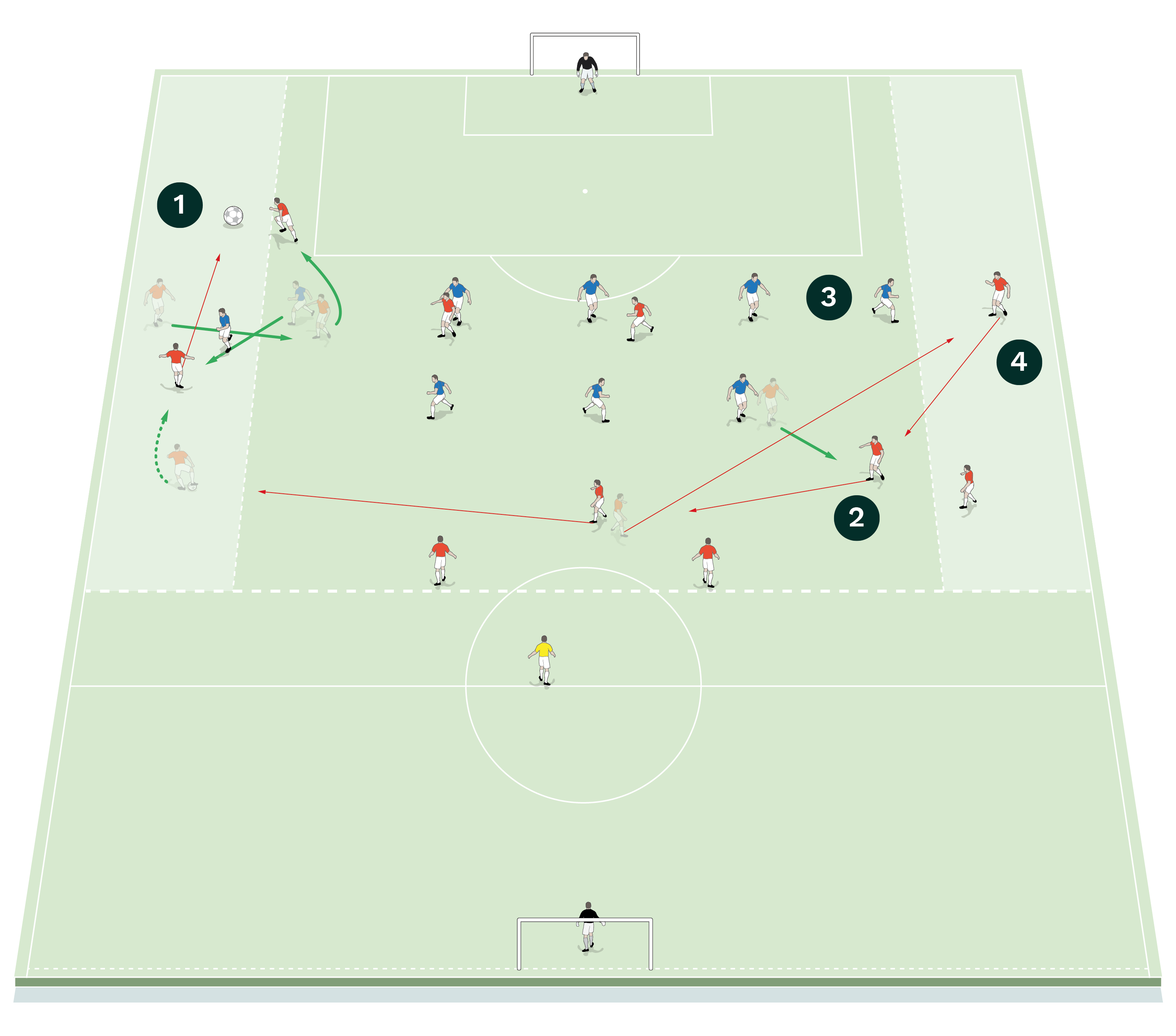
2. In the main central area of the pitch, the reds are limited to two touches to increase the fast tempo of the play
3. The blues have unlimited touches
4. In the wide channels the reds have unlimited touches
[3c]

2. The blues should counter-attack through the yellow forward, who can hold the ball up and link play as the blues break past the coned line
“The attacking team follows the same principles worked on in the previous activity, implementing the options that came out of the earlier analysis”
The red attacking team aims to follow the same principles worked on in the previous activity, by switching the play from flank to flank to exploit wide areas and create 2v1 situations, as shown [3b], implementing the various options and possible solutions that came out of the earlier analysis and training experiments.
In the main area of the pitch, the red players would be limited to two touches to increase the fast tempo of the play, while the blue players would have unlimited touches. In the wide channels the red players have unlimited touches to enable the solution to progress. We would tend to run three flank-to-flank plays and in the third one, the opposition midfielders cannot defend in the wide channels to facilitate the 2v1 situation against the blue wing backs.
If the defending team wins the ball, they must counter-attack and attempt to score past the red team’s goalkeeper. They should play through the yellow support player, who can hold the ball up and link play with the counter-attacking blues as they break past the coned line, as shown [3c].
Related Files
Editor's Picks
Using the goalkeeper in build-up play
Pressing principles
Intensive boxes drill with goals
Penetrating the final third
Creating and finishing
My philosophy
Pressing initiation
Compact team movement
Defensive organisation
Coaches' Testimonials

Alan Pardew

Arsène Wenger

Brendan Rodgers

Carlos Carvalhal

José Mourinho

Jürgen Klopp

Pep Guardiola

Roy Hodgson

Sir Alex Ferguson

Steven Gerrard
Coaches' Testimonials

Gerald Kearney, Downtown Las Vegas Soccer Club

Paul Butler, Florida, USA

Rick Shields, Springboro, USA

Tony Green, Pierrefonds Titans, Quebec, Canada
Join the world's leading coaches and managers and discover for yourself one of the best kept secrets in coaching. No other training tool on the planet is written or read by the calibre of names you’ll find in Elite Soccer.
In a recent survey 92% of subscribers said Elite Soccer makes them more confident, 89% said it makes them a more effective coach and 91% said it makes them more inspired.
Get Monthly Inspiration
All the latest techniques and approaches
Since 2010 Elite Soccer has given subscribers exclusive insight into the training ground practices of the world’s best coaches. Published in partnership with the League Managers Association we have unparalleled access to the leading lights in the English leagues, as well as a host of international managers.
Elite Soccer exclusively features sessions written by the coaches themselves. There are no observed sessions and no sessions “in the style of”, just first-hand advice delivered direct to you from the coach.



